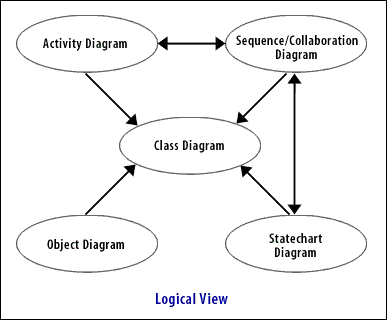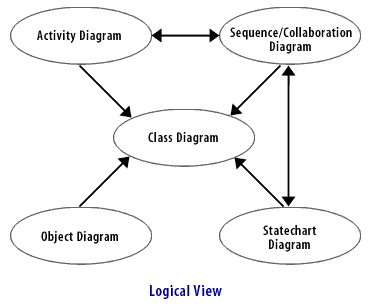| Lesson 7 | Logical View |
| Objective | Define the purpose and function of the logical view |
Purpose and Function of the Logical View
The logical view is by far the most inclusive of the views, since it contains six of the nine models.
Together, these diagrams are designed to model every aspect of a software solution, each diagram providing its own specialized portion of
the total specification for a system:
System Specification

- The primary diagram is the class diagram, which is the foundation for modeling objects, the source for code generation, and the target for reverse engineering.
- The object diagram illustrates objects rather than classes. The object diagram can be used to test or simply understand a class diagram. However, most CASE tool vendors do not support it at this time.
- For modeling object interactions, the logical view includes sequence and collaboration diagrams. These are two very similar views for identifying object interfaces and communication.
- To model internal object behavior, the statechart diagram provides a look at how an object reacts to external stimuli and manages internal changes.
- The activity diagram describes processes including sequence, conditional logic, and concurrency. This diagram is like a flowchart, but it has been enhanced for use with object modeling.
Logical view of UML
The logical view is a presentation dedicated to the description of conceptual analysis and design work products for a software project. Beginning with user requirements and progressing through the logical modeling of classes and objects and their interactions, you will move on to process modeling, and finally implementation modeling.

Design Views
The previous views model the concepts in the application from a logical viewpoint. The design views model the design structure of the application itself, such as its expansion into structured classifiers, the collaborations that provide functionality, and its assembly from components with well-defined interfaces. These views provide an opportunity to map classes onto implementation components and expand high-level classes into supporting structure. Implementation diagrams include the internal structure diagram, the collaboration diagram, and the component diagram.
UML Distilled
- The primary diagram is the class diagram, which is the foundation for modeling objects, the source for code generation, and the target for reverse engineering.
- The object diagram illustrates objects rather than classes. The object diagram can be used to test or simply understand a class diagram. However, most CASE tool vendors do not support it at this time.
- For modeling object interactions, the logical view includes sequence and collaboration diagrams. These are two very similar views for identifying object interfaces and communication.
- To model internal object behavior, the statechart diagram provides a look at how an object reacts to external stimuli and manages internal changes.
- The activity diagram describes processes including sequence, conditional logic, and concurrency. This diagram is like a flowchart, but it has been enhanced for use with object modeling.
Logical View
Your development methodology will determine when these models are used. However, the unique characteristics of each model make them particularly useful for solving specific problems. We will focus on their features and usage to provide you with the necessary information to decide when and how to apply them.
In the next lesson, the component view for modeling units of software according to function will be discussed.
The Logical view contains the following six models :
In the next lesson, the component view for modeling units of software according to function will be discussed.
- Activity Diagram
- Sequence
- Colaboration
- Class
- Object
- Statechart